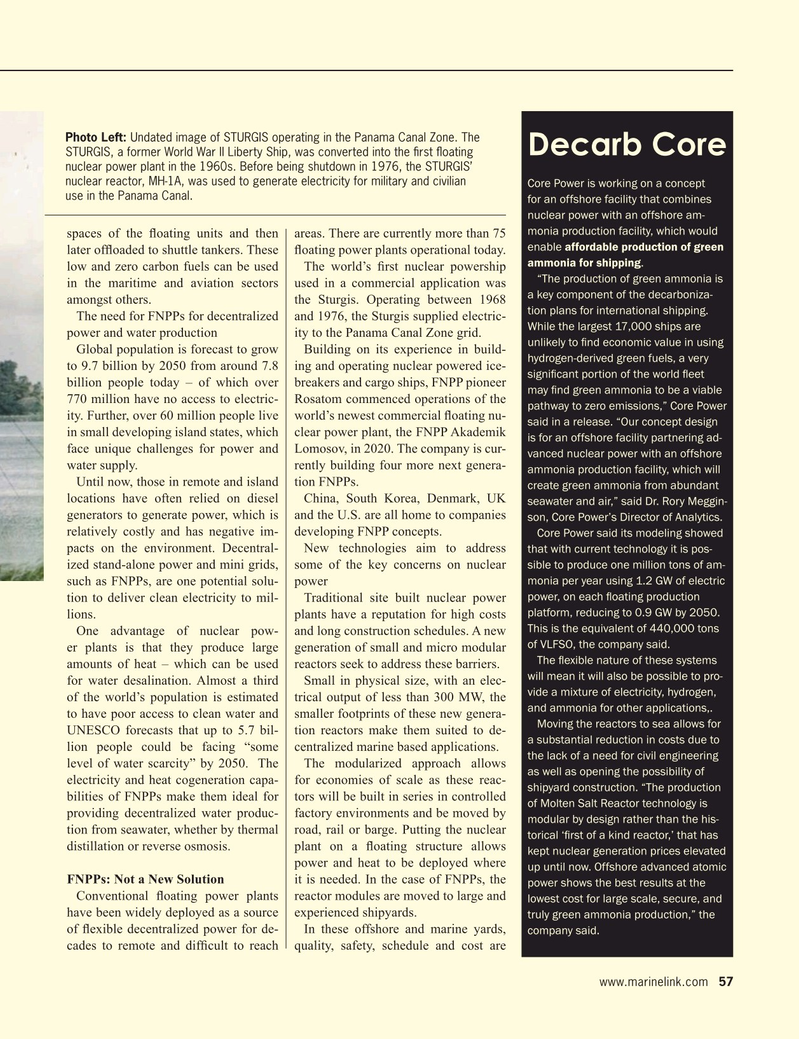
Page 57: of Maritime Reporter Magazine (February 2022)
Government Shipbuilding
Read this page in Pdf, Flash or Html5 edition of February 2022 Maritime Reporter Magazine
Photo Left: Undated image of STURGIS operating in the Panama Canal Zone. The
Decarb Core
STURGIS, a former World War II Liberty Ship, was converted into the ? rst ? oating nuclear power plant in the 1960s. Before being shutdown in 1976, the STURGIS’ nuclear reactor, MH-1A, was used to generate electricity for military and civilian
Core Power is working on a concept use in the Panama Canal.
for an offshore facility that combines nuclear power with an offshore am- monia production facility, which would spaces of the ? oating units and then areas. There are currently more than 75 enable affordable production of green later of? oaded to shuttle tankers. These ? oating power plants operational today.
ammonia for shipping.
low and zero carbon fuels can be used The world’s ? rst nuclear powership “The production of green ammonia is in the maritime and aviation sectors used in a commercial application was a key component of the decarboniza- amongst others. the Sturgis. Operating between 1968 tion plans for international shipping.
The need for FNPPs for decentralized and 1976, the Sturgis supplied electric-
While the largest 17,000 ships are power and water production ity to the Panama Canal Zone grid.
unlikely to ? nd economic value in using
Global population is forecast to grow Building on its experience in build- hydrogen-derived green fuels, a very to 9.7 billion by 2050 from around 7.8 ing and operating nuclear powered ice- signi? cant portion of the world ? eet billion people today – of which over breakers and cargo ships, FNPP pioneer may ? nd green ammonia to be a viable 770 million have no access to electric- Rosatom commenced operations of the pathway to zero emissions,” Core Power ity. Further, over 60 million people live world’s newest commercial ? oating nu- said in a release. “Our concept design in small developing island states, which clear power plant, the FNPP Akademik is for an offshore facility partnering ad- face unique challenges for power and Lomosov, in 2020. The company is cur- vanced nuclear power with an offshore water supply. rently building four more next genera- ammonia production facility, which will
Until now, those in remote and island tion FNPPs.
create green ammonia from abundant locations have often relied on diesel China, South Korea, Denmark, UK seawater and air,” said Dr. Rory Meggin- generators to generate power, which is and the U.S. are all home to companies son, Core Power’s Director of Analytics.
relatively costly and has negative im- developing FNPP concepts.
Core Power said its modeling showed pacts on the environment. Decentral- New technologies aim to address that with current technology it is pos- sible to produce one million tons of am- ized stand-alone power and mini grids, some of the key concerns on nuclear monia per year using 1.2 GW of electric such as FNPPs, are one potential solu- power power, on each ? oating production tion to deliver clean electricity to mil- Traditional site built nuclear power platform, reducing to 0.9 GW by 2050. lions. plants have a reputation for high costs
This is the equivalent of 440,000 tons
One advantage of nuclear pow- and long construction schedules. A new of VLFSO, the company said.
er plants is that they produce large generation of small and micro modular
The ? exible nature of these systems amounts of heat – which can be used reactors seek to address these barriers. will mean it will also be possible to pro- for water desalination. Almost a third Small in physical size, with an elec- vide a mixture of electricity, hydrogen, of the world’s population is estimated trical output of less than 300 MW, the and ammonia for other applications,.
to have poor access to clean water and smaller footprints of these new genera-
Moving the reactors to sea allows for
UNESCO forecasts that up to 5.7 bil- tion reactors make them suited to de- a substantial reduction in costs due to lion people could be facing “some centralized marine based applications. the lack of a need for civil engineering level of water scarcity” by 2050. The The modularized approach allows as well as opening the possibility of electricity and heat cogeneration capa- for economies of scale as these reac- shipyard construction. “The production bilities of FNPPs make them ideal for tors will be built in series in controlled of Molten Salt Reactor technology is providing decentralized water produc- factory environments and be moved by modular by design rather than the his- tion from seawater, whether by thermal road, rail or barge. Putting the nuclear torical ‘? rst of a kind reactor,’ that has distillation or reverse osmosis. plant on a ? oating structure allows kept nuclear generation prices elevated power and heat to be deployed where up until now. Offshore advanced atomic
FNPPs: Not a New Solution it is needed. In the case of FNPPs, the power shows the best results at the
Conventional ? oating power plants reactor modules are moved to large and lowest cost for large scale, secure, and have been widely deployed as a source experienced shipyards.
truly green ammonia production,” the of ? exible decentralized power for de- In these offshore and marine yards, company said.
cades to remote and dif? cult to reach quality, safety, schedule and cost are www.marinelink.com 57
MR #2 (50-59).indd 57 2/4/2022 9:07:31 AM

 56
56

 58
58
